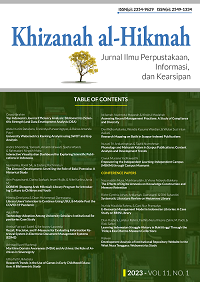Top Indonesia's Journal Efficiency Analysis: Bibliometrics (Scientific Strength) and Data Envelopment Analysis (DEA)
Abstract
This study aims to analyze the efficiency of a journal by examining the correlation between the number of researchers associated with the journal and the expenses borne by researchers for publication concerning the scientific strengths achieved. The analysis is conducted through the Data Envelopment Analysis (DEA) approach. The data for scientific journal articles is collected from the metadata of Scopus, and WoS (Web of Science) was indexed in SINTA 1. Meanwhile, the APC (Article publication charge) data was obtained from the journal website. The input variables include the author, the editorial team, and the APC. In contrast, the output variables in this study are the scientific strength (publications and citations) generated. The study showed that the SINTA 1 journal indexed in Scopus and WoS with a DEA value of 1,000 was Operations and Supply Chain Management: An International Journal. The DEA value for journals indexed in Scopus and WoS is greater compared to the DEA value of journals indexed in WoS, as opposed to the DEA value of journals indexed in Scopus, but the difference is small.
Downloads
References
Abramo, G., Cicero, T., & D’Angelo, C. A. (2011). A field-standardized application of DEA to national-scale research assessment of universities. Journal of Informetrics, 5(4), 618–628. https://doi.org/10.1016/j.joi.2011.06.001
Abramo, G., & D’Angelo, C. A. (2014). How do you define and measure research productivity? Scientometrics, 101(2), 1129–1144. https://doi.org/10.1007/s11192-014-1269-8
Abramo, G., D’Angelo, C. A., & Pugini, F. (2008). The measurement of Italian universities' research productivity by a non parametric-bibliometric methodology. Scientometrics, 76(2), 225–244. https://doi.org/10.1007/s11192-007-1942-2
Ahmed, S. A. M., Talib, M. A., Noor, N. F. M., & Jani, R. (2021). Evaluating the Efficiency of Faculties in University of Malaya Using Data Envelopment Analysis. Journal of Physics: Conference Series, 1860(1). https://doi.org/10.1088/1742-6596/1860/1/012024
Andersen, P., & Petersen, N. C. (1993). A Procedure for Ranking Efficient Units in Data Envelopment Analysis. Management Science, 39(10), 1261–1264. https://doi.org/10.1287/MNSC.39.10.1261
Andersson, C., & Sund, K. (2021). Technical Efficiency and Productivity of Higher Education Institutions in the Nordic Countries. International Journal of Public Administration, 00(00), 1–14. https://doi.org/10.1080/01900692.2020.1868508
Chen, K., Ren, X. T., & Yang, G. L. (2021). A novel approach for assessing academic journals: Application of integer DEA model for management science and operations research field. Journal of Informetrics, 15(3), 101176. https://doi.org/10.1016/J.JOI.2021.101176
Chen, K., Yang, G., & Khoveyni, M. (2017). Measuring Performance Evolution of Academic Journals in Management Science and Operations Research: A DEA-Malmquist Approach. Journal of Management Science and Engineering, 2(1), 34–54. https://doi.org/10.3724/SP.J.1383.201002
Chen, S. P., & Chang, C. W. (2021). Measuring the efficiency of university departments: an empirical study using data envelopment analysis and cluster analysis. Scientometrics, 126(6), 5263–5284. https://doi.org/10.1007/s11192-021-03982-3
Daraio, C., Lenzerini, M., Leporelli, C., Moed, H. F., Naggar, P., & Bonaccorsi, A. (2016). Data integration for research and innovation policy: an Ontology-Based Data Management approach. Scientometrics, December. https://doi.org/10.1007/s11192-015-1814-0
Gökşen, Y., Doğan, O., & Özkarabacak, B. (2015). A Data Envelopment Analysis Application for Measuring Efficiency of University Departments. Procedia Economics and Finance, 19(15), 226–237. https://doi.org/10.1016/s2212-5671(15)00024-6
Groot, T., & García-Valderrama, T. (2006). Research quality and efficiency. An analysis of assessments and management issues in Dutch economics and business research programs. Research Policy, 35(9), 1362–1376. https://doi.org/10.1016/j.respol.2006.07.002
Gușu, P. F., & Butnariu, A. R. (2021). Bibliometrics and Research Evaluation: Uses and Abuses (History and Foundations of Information Science). In The Annals of the University of Oradea. Economic Sciences TOM XXX (Issue July). The MIT Press.
Ibrahim, C., & Fadhli, R. (2021). Performance of Indonesia's World-Class University Efficiency with Bibliometrics (Scientific Strength) Approach and Data Envelopment Analysis. Webology, 18(1), 32–50. https://doi.org/10.14704/WEB/V18I1/WEB18003
Kemdikbud. (2019). Pedoman Operasional Penilaian Angka Kredit Kenaikan Jabatan Akademik/Pangkat Dosen.
Kuah, C. T., & Wong, K. Y. (2011). Efficiency assessment of universities through data envelopment analysis. Procedia Computer Science, 3, 499–506. https://doi.org/10.1016/j.procs.2010.12.084
Lee, H., & Shin, J. (2014). Measuring journal performance for multidisciplinary research: An efficiency perspective. Journal of Informetrics, 8(1), 77–88. https://doi.org/10.1016/j.joi.2013.10.004
Mutz, R., Bornmann, L., & Daniel, H. D. (2017). Are there any frontiers of research performance? Efficiency measurement of funded research projects with the Bayesian stochastic frontier analysis for count data. Journal of Informetrics, 11(3), 613–628. https://doi.org/10.1016/j.joi.2017.04.009
Ortega, F. J., & Gavilan, J. M. (2013). The measurement of production efficiency in scientific journals through stochastic frontier analysis models: Application to quantitative economics journals. Journal of Informetrics, 7(4), 959–965. https://doi.org/10.1016/j.joi.2013.09.004
Petridis, K., Malesios, C., Arabatzis, G., & Thanassoulis, E. (2013). Efficiency analysis of forestry journals: Suggestions for improving journals' quality. Journal of Informetrics, 7(2), 505–521. https://doi.org/10.1016/j.joi.2013.02.002
Qi, T., Zang, X., Bian, W., Zhen, J., & Li, X. (2022). Assessment of research efficiency of critical care medicine in hospitals affiliated S university based on data envelopment method: taking the 13th Five-Year Plan period as an example. Zhonghua Wei Zhong Bing Ji Jiu Yi Xue, 34(3), 294–300. https://doi.org/10.3760/CMA.J.CN121430-20220112-00050
Qiu, J., Zhao, R., Yang, S., & Dong, K. (2017). Informetrics. Springer Nature.
Rosenthal, E. C., & Weiss, H. J. (2017). A data envelopment analysis approach for ranking journals. Omega (United Kingdom), 70, 135–147. https://doi.org/10.1016/j.omega.2016.09.006
Rousseau, R., Egghe, L., & Guns, R. (2018). Becoming Metric-Wise: A Bibliometric Guide for Researchers. Chandos Publishing.
Rusyidiana, A. S. (2013). Measuring the Efficiency Level with the Data Envelopment Analysis (DEA) Method. SMART Consulting Team.
Yan, Y., Xia, J., Sun, D., & Hu, Q. (2022). Research on combination evaluation of operational stability of energy industry innovation ecosystem based on machine learning and data mining algorithms. Energy Reports, 8, 4641–4648. https://doi.org/10.1016/j.egyr.2022.02.178
Copyright (c) 2023 Cecep Ibrahim

This work is licensed under a Creative Commons Attribution-NonCommercial-ShareAlike 4.0 International License.
By submitting your manuscript to our journal, you are following Copyright and License

